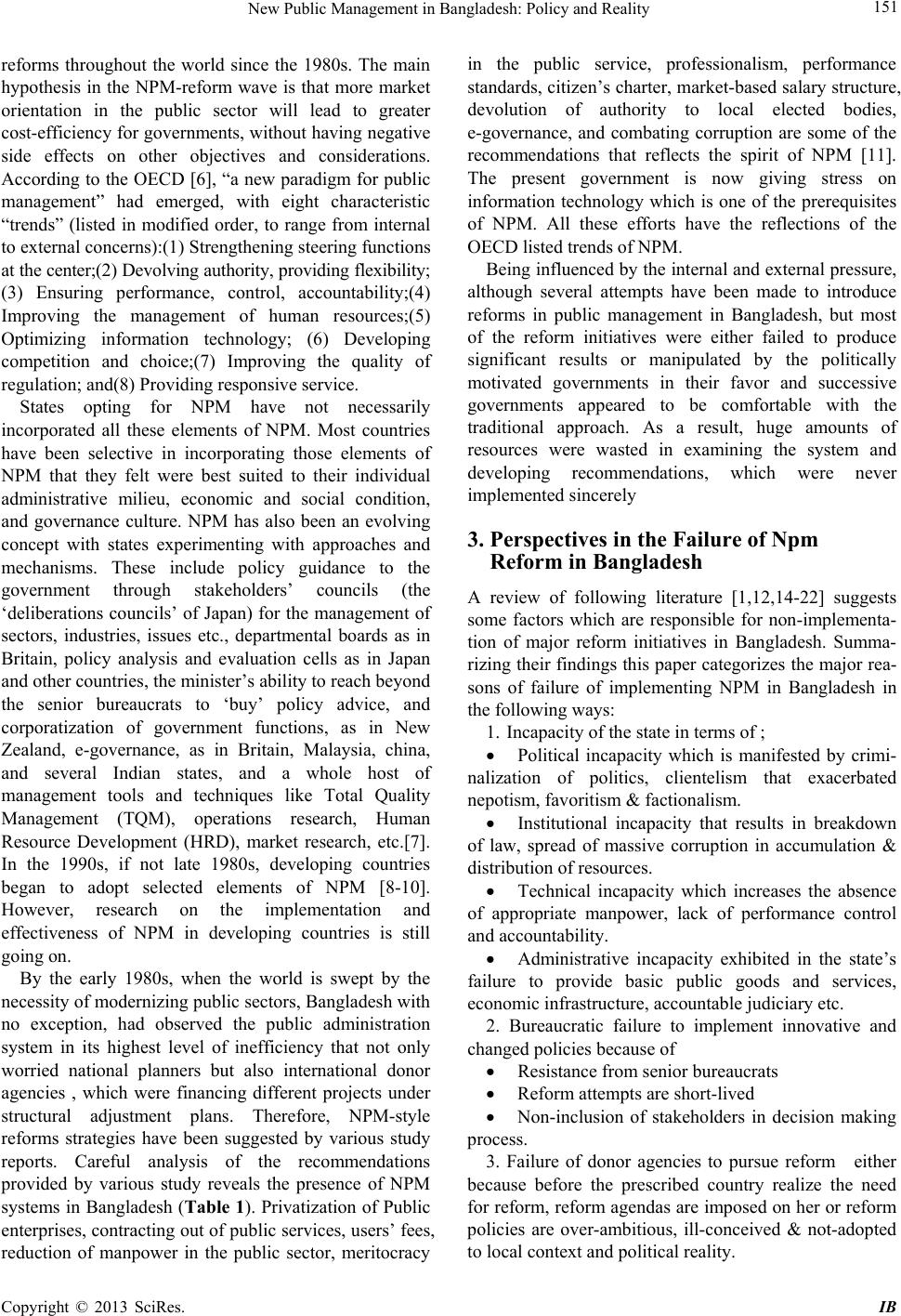
New Public Management in Bangladesh: Policy and Reality 151
reforms throughout the world since the 1980s. The main
hypothesis in the NPM-reform wave is that more market
orientation in the public sector will lead to greater
cost-efficiency for governments, without having negative
side effects on other objectives and considerations.
According to the OECD [6], “a new paradigm for public
management” had emerged, with eight characteristic
“trends” (listed in modified order, to range from internal
to external concerns):(1) Strengthening steering functions
at the center;(2) Devolving authority, providing flexibility;
(3) Ensuring performance, control, accountability;(4)
Improving the management of human resources;(5)
Optimizing information technology; (6) Developing
competition and choice;(7) Improving the quality of
regulation; and(8) Providing responsive service.
States opting for NPM have not necessarily
incorporated all these elements of NPM. Most countries
have been selective in incorporating those elements of
NPM that they felt were best suited to their individual
administrative milieu, economic and social condition,
and governance culture. NPM has also been an evolving
concept with states experimenting with approaches and
mechanisms. These include policy guidance to the
government through stakeholders’ councils (the
‘deliberations councils’ of Japan) for the management of
sectors, industries, issues etc., departmental boards as in
Britain, policy analysis and evaluation cells as in Japan
and other countries, the minister’s ability to reach beyond
the senior bureaucrats to ‘buy’ policy advice, and
corporatization of government functions, as in New
Zealand, e-governance, as in Britain, Malaysia, china,
and several Indian states, and a whole host of
management tools and techniques like Total Quality
Management (TQM), operations research, Human
Resource Development (HRD), market research, etc.[7].
In the 1990s, if not late 1980s, developing countries
began to adopt selected elements of NPM [8-10].
However, research on the implementation and
effectiveness of NPM in developing countries is still
going on.
By the early 1980s, when the world is swept by the
necessity of modernizing public secto rs, Bang ladesh with
no exception, had observed the public administration
system in its highest level of inefficiency that not only
worried national planners but also international donor
agencies , which were financing different projects under
structural adjustment plans. Therefore, NPM-style
reforms strategies have been suggested by various study
reports. Careful analysis of the recommendations
provided by various study reveals the presence of NPM
systems in Bangladesh (Table 1). Privatization of Public
enterprises, contracting out of pu blic services, users’ fees,
reduction of manpower in the public sector, meritocracy
in the public service, professionalism, performance
standards, citizen’s charter, market-based salary structure,
devolution of authority to local elected bodies,
e-governance, and combating corruption are some of the
recommendations that reflects the spirit of NPM [11].
The present government is now giving stress on
information technology which is one of the prerequisites
of NPM. All these efforts have the reflections of the
OECD listed trends of NPM.
Being influenced by the internal and external pressure,
although several attempts have been made to introduce
reforms in public management in Bangladesh, but most
of the reform initiatives were either failed to produce
significant results or manipulated by the politically
motivated governments in their favor and successive
governments appeared to be comfortable with the
traditional approach. As a result, huge amounts of
resources were wasted in examining the system and
developing recommendations, which were never
implemented sincerely
3. Perspectives in the Failure of Npm
Reform in Bangladesh
A review of following literature [1,12,14-22] suggests
some factors which are responsible for non-implementa-
tion of major reform initiatives in Bangladesh. Summa-
rizing their findings this paper categorizes the major rea-
sons of failure of implementing NPM in Bangladesh in
the following ways:
1. Incapacity of the state in terms of ;
Political incapacity which is manifested by crimi-
nalization of politics, clientelism that exacerbated
nepotism, favoritism & factionalism.
Institutional incapacity that results in breakdown
of law, spread of massive corruption in accumulation &
distribution of resources.
Technical incapacity which increases the absence
of appropriate manpower, lack of performance control
and accountability.
Administrative incapacity exhibited in the state’s
failure to provide basic public goods and services,
economic infrastructure, accountable judiciary etc.
2. Bureaucratic failure to implement innovative and
changed p o licie s bec ause of
Resistance from senior bureaucrats
Reform attempts are short-lived
Non-inclusion of stakeholders in decision making
process.
3. Failure of donor agencies to pursue reform either
because before the prescribed country realize the need
for reform, reform agendas are imposed on her or reform
policies are over-ambitious, ill-conceived & not-adopted
to local context and political reality.
Copyright © 2013 SciRes. IB